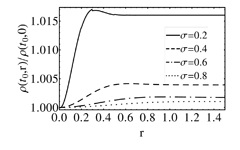Accueil
Primordial curvature perturbations and the cosmological constant (Vol. 45 No.5-6)

The standard cosmological model is based on the assumption that the Universe is homogeneous and isotropic on a sufficiently large scale. Inflation can give a natural explanation to this large scale homogeneity, through a sufficiently long period of exponential expansion of the Universe, but it also predicts the existence of perturbations of the metric, which are in good agreement with the observed anisotropy of the cosmic microwave background radiation or the large structure of the spatial distribution of galaxies.
This is the motivation to study the effects on the luminosity distance of a local inhomogeneity seeded by primordial curvature perturbations of the type predicted by the inflationary scenario. We find that a local underdensity originated from one, two or three standard deviations peaks of the primordial curvature perturbations field can induce corrections to the value of a cosmological constant of the order of 0.6%, 1%, 1.5%, respectively.
Our results can be considered an upper bound for the effect of the monopole component of the local non-linear structure which can arise from primordial curvature perturbations and requires a fully non-perturbative relativistic treatment.
A. E. Romano, S. Sanes Negrete, M. Sasaki and A. A. Starobinsky, “Non-perturbative effects of primordial curvature perturbations on the apparent value of a cosmological constant”, EPL, 106, 69002 (2014)
[Abstract]
Optimum inertial self-propulsion design for snowman-like nanorobot (Vol. 45 No.5-6)

Credit: Nadal et al.
A new study investigates the effects of small but finite inertia on the propulsion of micro and nano-scale swimming machines that could have implications for biomedical applications.
Scale plays a major role in locomotion. Swimming microorganisms, such as bacteria and spermatozoa, are subjected to relatively small inertial forces compared to the viscous forces exerted by the surrounding fluid. Such low-level inertia makes self-propulsion a major challenge. Now, the authors have found that the direction of propulsion made possible by such inertia is opposite to that induced by a viscoelastic fluid. This study could help optimise the design of self-propelled micro- and nanoscale artificial swimming machines to improve their mobility in medical applications. The study shows that a rotating dumbbell propels with the large sphere due to intertial forces in the fluid and the small sphere ahead in a pure viscoelastic fluid. The authors then derive the optimal dumbbell geometry for a self-propelling small-scale swimmer.
F. Nadal, O. S. Pak, L. Zhu, L. Brandt and E. Lauga, “Rotational propulsion enabled by inertia”, Eur. Phys. J. E 37, 60 (2014)
[Abstract]
Water window imaging opportunity (Vol. 45 No.5-6)

Credit: Pérez-Hernández et al.
A new theoretical study elucidates mechanisms that could help in producing coherent radiations, and could ultimately help to achieve high-contrast images of biological samples.
Ever heard of the water window? It consists of radiations in the 3.3 to 4.4 nanometre range, which are not absorbed by the water in biological tissues. New theoretical findings show that it is possible to develop coherent radiations within the water window. These could be the basis of an optimal technique to obtain a high-contrast image of the biological samples or to be used in high-precision spectroscopy. Now, a new theoretical study identifies the physical mechanism needed to efficiently generate the harmonic radiations at high laser intensities that occur beyond the saturation threshold of atoms and molecules. These findings, aimed at improving conventional methods of coherent radiation production to reach the water window, were recently found by the authors. In previous similar work, studies focused on hydrogen as the atomic target. In the present work, the authors extend the study to argon atoms.
J. A. Pérez-Hernández, M. F. Ciappina, M. Lewenstein, A. Zaïr and L. Roso (2014), “High-order harmonic generation at high laser intensities beyond the tunnel regime”, Eur. Phys. J. D 68, 195 (2014)
[Abstract]
Boundary dynamics driven entanglement (Vol. 45 No.5-6)

Quantum control in its many facets is a key notion in quantum information technologies. Manipulating quantum states, preparing them according to given specifications, running quantum algorithms and eventually measuring certain observables are some of the main operations requested in almost all applications of quantum mechanics.
The quantum gates, or unitary operators, used to do these tasks can be manipulated by modifying the boundary conditions of the system. This has the advantage, over other quantum computation schemes, that no interaction with the bulk of the system is needed.
Mathematically, to address the problem of considering different boundary conditions is equivalent to address the problem of fixing different self-adjoint extensions of the corresponding symmetric operators describing the dynamics.
We study the space of self-adjoint extensions of bipartite systems and show that their space of self-adjoint extensions is much larger than the spaces of self-adjoint extensions of the separate parties. We exploit this difference to show how to generate entangled states from untentangled ones.
As an example we analyze the hybrid system consisting of a planar quantum rotor and a spin system under a wide class of boundary conditions. We call this bipartite system a quantum compass (see Figure).
A. Ibort, G. Marmo and J. M. Pérez-Pardo, “Boundary dynamics driven entanglement”, J. Phys. A: Math. Theor. 47, 385301 (2014)
[Abstract]







